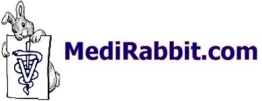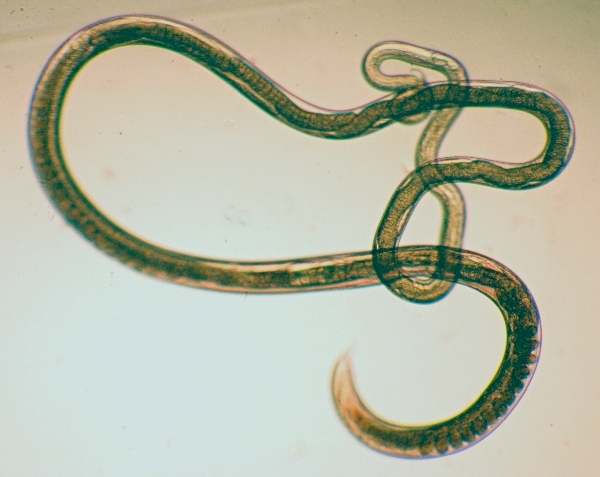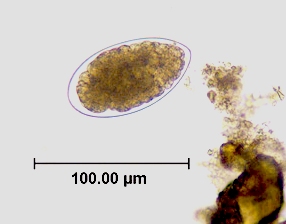Trichostrongylus
calcaratus
Esther van
Praag, Ph.D.
MediRabbit.com is funded solely by the
generosity of donors.
Every donation, no matter what
the size, is appreciated and will aid in the continuing research of medical care
and health of rabbits.
Thank you
|
|
Trichostrongylus
parasitic worms are commonly observed to
infest wild rabbits and cottontails, in particular the eastern cottontail (Sylvilagus
floridanus) in the USA. They are rare in pet rabbits. Trichostrongylus
calcaratus is found in the small intestine and the colon of the rabbit.
Extra-intestinal migration is unknown. The rabbits become infested by eating
food (hay, straw, fresh vegetables) that has been contaminated by the larvae.
This
parasite does not represent a public health danger. The
eggs produced by the female will pass in the feces and hatch outside the
host. They measure between 80 and 90 mm
(micrometer) long. They are already segmented when laid and develop into
infective larvae within 6 days. The L1 and L2 stages of
the larvae are microbivorous. The L3 stage, reached after 16-18
days, is non-feeding and infective by ingestion. L3, L4
and L5 are immature adults that develop into mature forms in the
digestive tract of the host. The life cycle is direct, with no intermediate
hosts. The worms are slim, with small anterior
ends and no buccal cavity. Male worms can be recognized by their asymmetrical
dorsal ray and two short nearly equal spicules. The female has a vulva of
about 1 mm near the tip of the tail. Often eggs can be observed in
her body.
Several Trichostrongylus species
have been observed in rabbits. They can be differentiated by the size and the
structures of the spicules. Trichostrongylus affinis
This strongyle parasitic worm is found
throughout the USA, and infests cottontails (Sylvilagus floridanus)
and snowshoe hares (Lepus americanus). It is rare in pet rabbits. It
infects the cecum and the large intestine. The eggs, which measure an average of 61
* 37 mm, will pass with the feces. They hatch
and develop outside the host and the larvae become infective after about 10
days. The adult worms have an average size of 5-7.5 mm for the males and
8.7-9.3 mm for the females. The male possesses spicules, while the female has
a vulva at the posterior end. Severe infestation can cause a loss of
weigh. Trichostrongylus retortaeformis
This parasite is found only in Europe,
the UK, and was introduced to Australia. It lives in the small intestine of
rabbits and hares (Lepus europaeus). Its life cycle is probably
similar to that of T. affinis. The eggs measure about 87 * 33 mm. They are found in the portion of
herbage that presents the least climatic changes. Their development fails
when the maximum temperatures do not exceed 10°C. The larvae are able to
migrate inside the vegetation to moist conditions. The adult worms measure
between 6.8 and 8.4 mm long for the males and 9.6 and 10.4 mm long for the
females. They are characterized by thin transverse and longitudinal grooves. Pathogenesis related to the presence of Trichostrongylus
retortaeformis can affect and reduce a population of rabbits. Clinical
test include fecal flotation at 25°C. Higher temperatures will kill the
parasite. Trichostrongylus ransomi
Trichostrongylus ransomi has been reported to infest cottontails
(Sylvilagus floridanus) in Louisiana, USA. It is not frequent in
rabbits. It infests the small intestine. The life cycle of this worm is
unknown but probably similar to that of T. affinis. The eggs measure about 65 * 33 mm. The adult worms are small: 2.2 - 3 mm
for the males and 3 - 3,5 mm for the females. Trichostrongylus colubriformis (T. instabilis)
It is a cosmopolitan parasite that
infests the small intestine of cattle and other ruminants, but also
lagomorphs. Clinical signs
The
intrinsic pathogenic strength of these worms is weak and the rabbit remains
asymptomatic in most cases. Severe infestation can, however, lead to a weight
loss and/or anemia and aggravate other rabbit disorders, such as diarrhea,
cause high eosinophilia and occasionally death. The mucous layer of the
intestine is often irritated, which can lead to blood loss, sometimes the
presence of nodules is observed. The presence of Trichostrongylus
worms is diagnosed by fecal flotation for the presence of strongyle-type eggs
in the feces. The culture of these eggs to the L3 stage is
necessary for a specific identification of the species. Adults can be
specifically identified by their structure and appendices. Treatment
Further Information
Anderson RC (2000) Nematode Parasites of
Vertebrates. Their Development and Transmission. 2nd Ed. CABI
Publishing, Oxon, UK. Andrews CL,
Davidson WR. Endoparasites of selected populations of
cottontail rabbits (Sylvilagus floridanus) in the southeastern United
States. J Wildl Dis.
1980; 16(3):395-401. Audebert F, Cassone J, Hoste H, Durette-Desset MC. Morphogenesis and distribution of Trichostrongylus
retortaeformis in the intestine of the rabbit. J Helminthol. 2000; 74(2):95-107. Audebert F,
Hoste H, Durette-Desset MC. Life cycle of Trichostrongylus
retortaeformis in its natural host, the rabbit (Oryctolagus cuniculus).
J Helminthol.
2002; 76(3):189-92. Boag B. The incidence of helminth parasites from the wild rabbit Oryctolagus
cuniculus (L.) in eastern Scotland. J Helminthol. 1985; 59(1):61-9. Boag B, Iason
G. The occurrence and abundance of helminth parasites
of the mountain hare Lepus timidus (L.) and the wild rabbit Oryctolagus
cuniculus (L.) in Aberdeenshire, Scotland. J Helminthol. 1986; 60(2):92-8. Ciordia H
BIZZELL WE, Porter DA, Dixon CF. The effect of
culture temperature and age on the infectivity of the larvae of Trichostrongylus
axei and T. colubriformis in rabbits and guinea pigs. J Parasitol.
1966; 52(5):866-70. Duwel D,
Brech K. Control of oxyuriasis in rabbits by
fenbendazole. Lab Anim. 1981; 15(2):101-5. Hoste H,
Reilly M. Scanning electron microscopy of the
jejunal and ileal mucosa of rabbits infected with Trichostrongylus
colubriformis. Ann Rech Vet. 1988; 19(2):123-8. Hoste H,
Mallet S. Effects of size of Trichostrongylus
colubriformis infections on histopathology of the mucosa along the whole
small intestine in rabbits. Hoste H, Mallet S, Koch C. Trichostrongylus colubriformis
infection in rabbits: persistence of the distal adaptive response to
parasitism after anthelmintic treatment. J Comp Pathol. 1995; 113(2):145-53. Iason GR, Boag B. Do intestinal helminths affect condition and
fecundity of adult mountain hares? J Wildl Dis. 1988; 24(4):599-605. Molina X, Casanova JC, Feliu C. Influence of host weight, sex and
reproductive status on helminth parasites of the wild rabbit, Oryctolagus
cuniculus, in Navarra, Spain. J Helminthol. 1999; 73(3):221-5. Prasad D, The effects of temperature and humidity on the free-living
stages of Trichostrongylus
retortaeformis. Can. J. Zool. 1959; 37: 305-316. Purvis GM,
Sewell MM. The host-parasite relationship between
the domestic rabbit and Trichostrongylus colubriformis. Vet Rec.
1971; 89(5):151-2. Strohlein DA,
Christensen BM. Metazoan parasites of the eastern
cottontail rabbit in western Kentucky. J Wildl Dis. 1983; 19(1):20-3. Wiggins JP,
Cosgrove M, Rothenbacher H.Gastrointestinal parasites of the
eastern cottontail (Sylvilagus floridanus) in central Pennsylvania. |
||||||||||||||
e-mail: info@medirabbit.com





